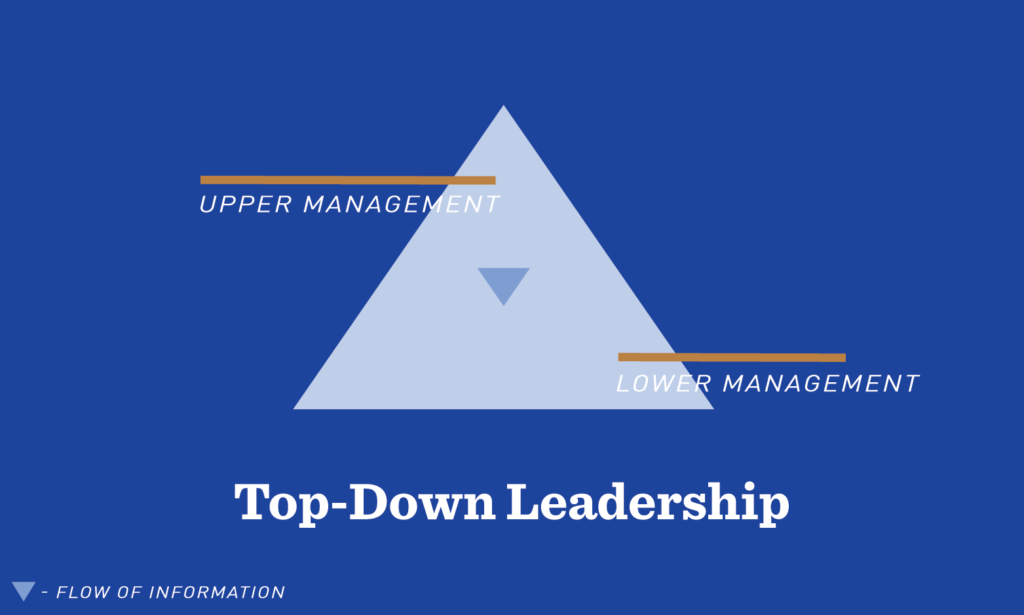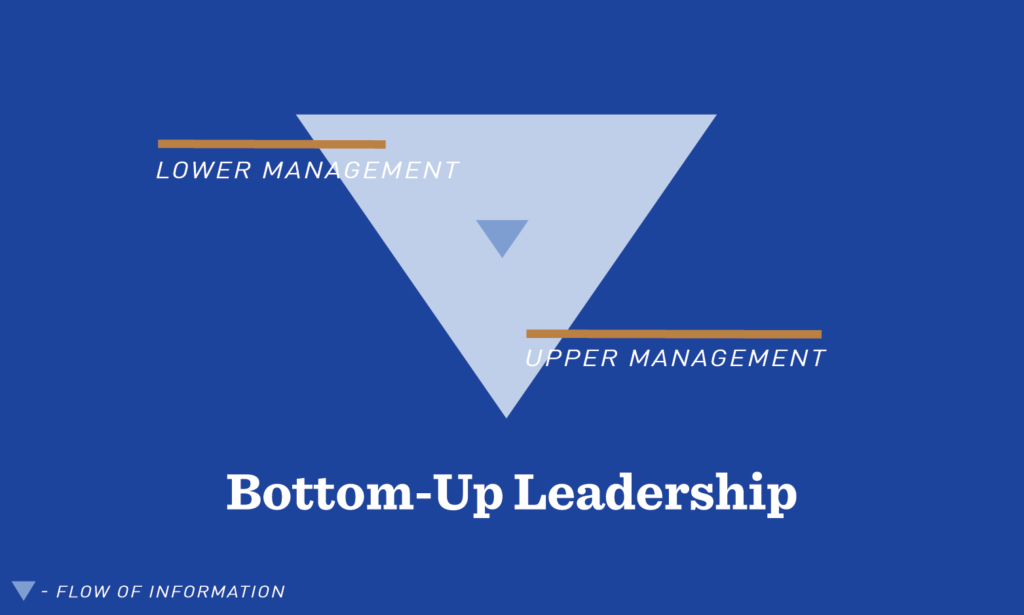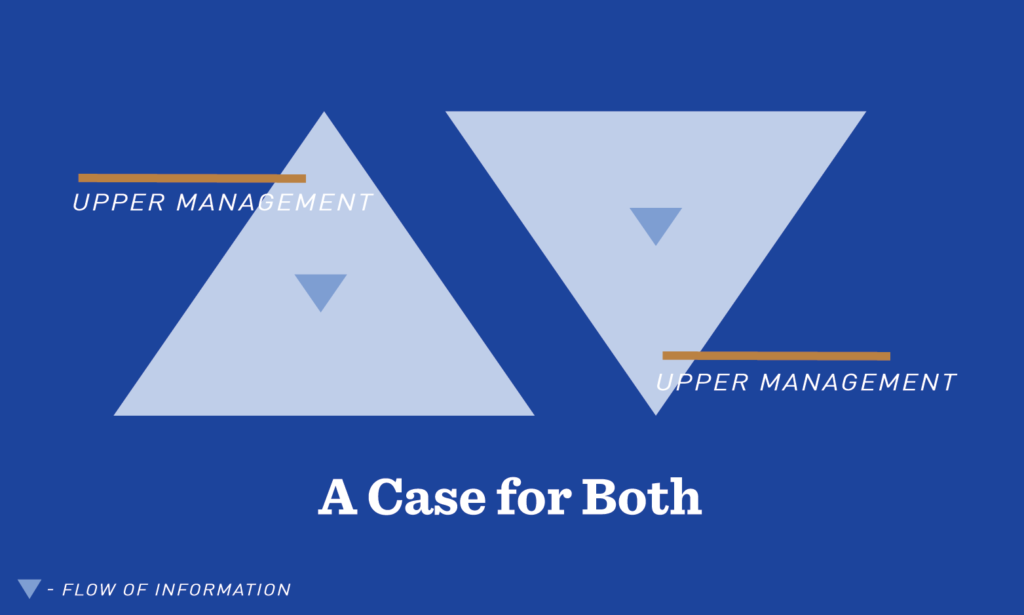When you think of leadership, do you picture one person leading the way for a whole group of people? A sole leader giving orders that are followed by subordinates? Someone who’s constantly stressed because of all the high-pressured decision-making that falls on their shoulders?
If these are your ideas of leadership, you’re not wrong. The fact is this type of management is common in our past and present societies. This type of structure is called top-down leadership, where the highest levels of an organization make decisions that are then distributed and executed by lower-tier management and employees.

Top-down leadership style. Where the highest levels of an organization make decisions that are then distributed and executed by lower-tier management and employees.
However, there is also bottom-up leadership, in which lower-tier employees collaborate and implement their own ideas and decisions that affect the organization as a whole.
Why Bottom-Up Leadership?
In bottom-up leadership, those at the top of the pyramid welcome the shared expectations, values and ideas from those under them to create plans and execute change. In today’s terms, they collaborate with the frontline workers, the associates who deliver services or products and make up the pyramid’s foundation. They have a better perspective than anyone on what the everyday operations are and what the organization needs to run efficiently.

In bottom-up leadership, the pyramid is flipped. Those at the top of the pyramid welcome the shared expectations, values and ideas from those under them to create plans and execute change.
Has there been a time when upper management implemented directives that didn’t make sense and left employees frustrated? This was probably due to a disconnect between decision-makers and everyday operations. Think of the president of a company. They have a big picture of the company’s goal and what their future should be. However, being so far up, they don’t often hold a full understanding of the needs of the pyramid’s foundation. A change from top-down management could greatly benefit the organization.
In bottom-up leadership, those at the top of the pyramid welcome the shared expectations, values and ideas from those under them to create plans and execute change.
Since most people would prefer to be involved in change rather than have it thrust upon them, there is more participation and ownership over ideas from frontline associates in bottom-up management. Employees are empowered by practicing their leadership skills and everyone collaborates democratically. Meanwhile, those in upper leadership offer support, feedback and resources and as a byproduct, communication travels faster. Ultimately, senior management still has the final decision on whether or not to greenlight any new ideas or strategies, but everyone has a stake in initiatives because they helped conceive and execute them. This, in turn, makes participants more responsible and productive in the organization.

Outward Bound students taking ownership of the day’s navigation plan. Photo by Jon Reynolds.
Leading by Example in the Face of a Pandemic
Here is an example of how I’ve seen this work: I’ve been working at Boston University as a supervisor at a COVID-19 collection site since August 2020. In the beginning, my team and I were instructed on how to collect nasal samples and direct foot traffic at the collection sites. Directions came from high-level health directors and heads of the collection initiative. We all found our groove confronting a health crisis never seen before, but this was only after three months of top-down management.
After that point, we adopted a bottom-up management style when frontline specialists noticed ways to improve. Some small but important changes were suggested by COVID-facing workers to upper-level management. Suggestions based on observations that might have otherwise gone unnoticed. These suggestions were then implemented. Supervisors became more receptive to their teams, and employees not only gave feedback about how collection procedures could be more efficient in obtaining the best possible sample, but how to boost morale.
This shift wasn’t a conscious decision, but instead, a natural transition as directors supported and listened to us throughout the whole endeavor.
This shift wasn’t a conscious decision, but instead, a natural transition as directors supported and listened to us throughout the whole endeavor. By listening to their employees’ ideas and needs, they empowered us and earned our trust. Nothing is perfect obviously, but I don’t think we could have been as successful in controlling infections at BU if we were only strictly using top-down leadership.
When to Take the Reins
There is a time and place for everything—bottom-up leadership shouldn’t be used all the time. In times of crisis, or when immediate action is needed, one voice is crucial for leading the whole. Multiple people attempting to make a unanimous decision during an emergency will lead to confusion and fracture the group, which could result in an even worse situation. During these times, one person needs to grab the reins, make a decision and look to their team to execute that plan so as not to waste time.

Both types of leadership styles are necessary for good, productive decisions to be made.
Bottom-up Leadership in Outward Bound
On an Outward Bound expedition, participants experience both top-down and bottom-up leadership. In the beginning, Instructors manage their crew top-down, teaching participants navigation, packing and group management. The beginning of the course is known as the learning phase when the crew is largely dependent on the Instructors for guidance and instruction. A period when most students have never backpacked or are unfamiliar with the outdoors.
However, as days go by, each student learns how to be an effective member of their crew and becomes accustomed to the daily flow of the course. Gradually there is a “transition of power” in a way from Instructors to students. Students who were once novices in navigation and leading, now know how to manage their food supply, they begin leading meetings and eventually begin even addressing conflict.

A student on an Outdoor Educator course steps into her role as the day’s leader and shares the navigation plan with her crew. Photo by Charis Nichols.
Eventually, Outward Bound students lead their whole crew and make decisions that drive the course. During group meetings, each member voices their opinions on how the crew could operate better and offer group strategies. Done well, fluctuating between top-down and bottom-up leadership during an Outward Bound expedition leads to a more effective, more communicative and higher-functioning group. The same could be said about the workplace if applied correctly.
Getting Past the Productivity Plateau
If you’ve only been managing top-down and have hit a plateau in either productivity or morale, have your group voice their ideas or strategies they think could benefit the team. They most likely have been reluctant to say anything due to the structure of the system. Hopefully, you’ll be introduced to new ideas and practices that will not only increase productivity but team morale. An effect that will then again increase productivity. See where this is going?
Remember, as a leader, you will have the final say whether a new initiative is implemented or not, but having your team take the lead will not only foster a more innovative and positive working environment but also prepare each individual for the future, once it’s their time to head their own group.
About the Author
Victor instructed for New York City Outward Bound Schools (NYCOBS) and was a climbing and kayak Instructor at Boston University where he led trips around the New England area. He continues to work for Boston University but now as a Site Supervisor, managing a team of 11 specialists at a Covid-19 collection site, which tests all staff, employees and students. In his free time, he’s either shooting/editing videos, performing music or creating content for online publication.
OTHER POSTS YOU MAY LIKE
Read More
Read More
Read More




